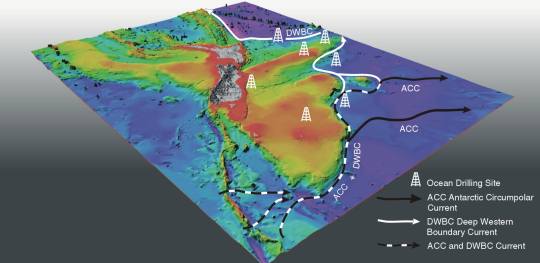Research projects
Explore joint projects between the Antarctic Research Centre and the Integrated Ocean Drilling Programme.
Antarctic Research Centre staff and students have a long association with the IODP Program and its predecessors, dating back to 1972-73 when Peter Barrett sailed as a sedimentologist on Leg 28 of the Deep Sea Drilling Project, the first deep drilling expedition undertaken in Antarctic waters.
During this expedition, the Glomar Challenger sailed into the Ross Sea and drilled four sedimentary drill cores on the Ross continental shelf (DSDP 270-273). The cores were of marine glacial sediment, indicating extensive ice-rafting and implying that glaciers were calving ice at sea level at least 25 million years ago. This was the first evidence that the continent had acquired an ice cover much earlier than in the last 2 million years, the common belief of the times.
More recently, Leg 181 of the Ocean Drilling Program drilled seven sites off eastern New Zealand with the primary aim of evaluating the paleoceanographic evolution of a key region that includes the SW Pacific gateway for the largest deep inflow of the thermohaline circulation, derived from the Antarctic Circumpolar Current.
The project was proposed by Lionel Carter (ARC) and Bob Carter (James Cook University, Australia), with Bob Carter and Nick McCave (Cambridge University, UK) as the co-chief scientists. Between August and October 1998, the Joides Resolution drilled in water depths down to 4435 m and recovered 3.6 km of core that served as the foundation for a major research effort that continues today. This has resulted in the publication of a wide range of papers (>70) which are still coming out in the international literature, and the work is ongoing, with the cores obtained in this becoming a critical component of the ANZICE programme.

Prior to joining the Antarctic Research Centre, Gavin Dunbar sailed on ODP Leg 172, and helped develop a high-resolution reconstruction of Quaternary paleooceanography in the North West Atlantic.
Several Antarctic Research Centre staff members (Rob McKay, Tim Naish, and Lionel Carter) have been selected to participate during New Zealand’s first year of membership of IODP on Leg 318 to recover sediment cores from five sites off the Wilkes Land margin of the East Antarctic Ice Sheet (EAIS).
This proposal contrasts with and complements the ANDRILL Program, which focused on the much smaller, but highly dynamic West Antarctic Ice Sheet. Unlike the former programme, the IODP cores will provide a unique transect from the continental shelf to the rise, allowing the shallow-marine (less-complete) physical evidence for past ice margin fluctuations to be traced into more complete and readily-dated, deeper marine records.
This research is anticipated to provide an unprecedented long-term history of the EAIS since its inception (~36-33 million years ago), through its transition from warmer ephemeral ice sheets, to a more permanent, cold polar ice sheet (~15 to 3 million years ago).
Ice sheet modelling studies indicate that the low-lying Wilkes Land region may be one of the most dynamic parts of the EAIS during past orbital-scale climate cycles. Moreover new satellite altimetry data show that this region is presently losing mass, and may be a significant contributor to future sea-level rise.
Leg 318 also plans to recover an ultra-high resolution (ie: annual to decadal), 230-m thick sedimentary record of climate/ocean variability during the Holocene and possibly back to the Last Glacial Termination ~18,000 years ago.
This Holocene record is expected to contain a history of:
- abrupt climate change identifying how Antarctic change links with similar perturbations in the Northern Hemisphere
- the role of key sea level events (e.g. Meltwater Pulse 1A/B) and oceanic warming in the deglaciation history of Antarctica since the Last Glacial Maximum
- oceanic circulation and bottom water production during the post glacial warming.
